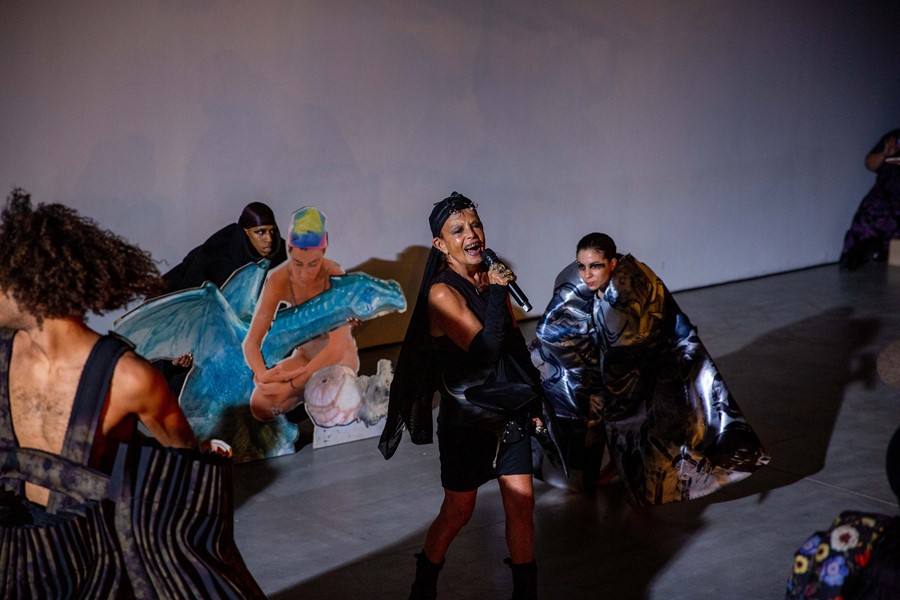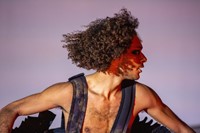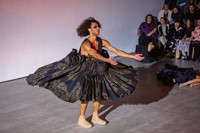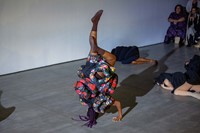A collaborative endeavour by choreographer and artist Cecilia Bengolea, ‘Before we die’ was part of this year’s Performa, the New York biennale which celebrates performance art. Speaking to Shonagh Marshall, the duo discuss this “ritualistic dance”
Sitting on the floor in the Jeffrey Deitch space on Wooster Street, performers stalked past me into the thrust space – demarcated by the eclectic audience members who are squeezed into the nooks and crannies, craning with anticipation. The music began with a pulsating, impending womp, signalling the cue for Michèle Lamy, dressed all in black, her signature ringed, inked fingers clutching a microphone, to begin giggling, ominously. Scattered across the floor laid Comme des Garçons archive pieces from Lamy’s personal collection, the performers circled one each and carefully clambered in, a few left untouched stayed static, like sculptures, throughout.
I had come to see the collaborative endeavour by choreographer and artist Cecilia Bengolea and artist, designer and singer Lamy, part of this year’s Performa, the New York biennale which celebrates performance art. Before we die was described as a ritualistic dance exploring the relationship between the human, animal and elemental world. The performance unfurled slowly, climaxing with a bombastic exit onto the street, all cast members dancing with abandon.
When I asked Bengolea what performance meant to her she said, “I’m interested in the dimensions of time and space that exist in performance. How we live together through a rhythm – how we breathe and think together, both performer and audience. It is an act of togetherness.” Here, she and Lamy discuss the piece in more detail.
Shonagh Marshall: Where did the idea come from to work together on a piece for Performa?
Michèle Lamy: Cecilia contacted me out of the blue. I had seen her performances as part of Elevation 1049 in Gstaad in 2017, so I was familiar with her work.
Cecilia Bengolea: I met Michèle this summer in Paris; we had seen each other before in Gstaad but never spoken. I loved that she always wore mesmerising creations by Comme de Garçons. I admire Michèle because she is the only person I know who transforms herself everyday in a ritualistic way. I explained that I wanted to do something with her and she suggested we use her Comme collection, which was stored in Italy but hadn’t had a performative life before. This was a dream of mine as I have always viewed Rei Kawakubo’s creations with so much emotion. To me she is a genius, and in her work she reinvents bodies. She’s a real punk.
ML: My archive of Comme pieces is made up of pieces I have bought over the last seven years. Some were from before the Met exhibition and some are from after. I thought they would be impossible for a dancer to dance in, but it was possible!
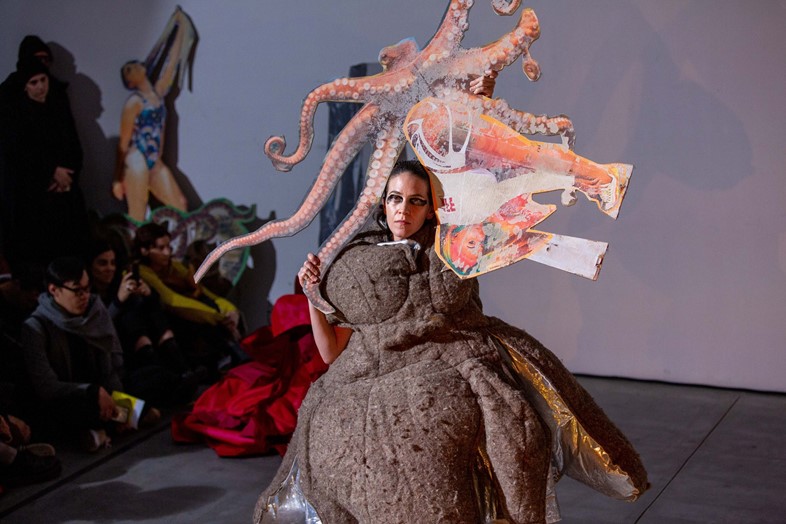
SM: What was the process from there?
CB: Michèle played me the music she makes as part of LAVASCAR, which is very intense, minimal and deep. I loved it and thought it was perfect for the performance.
ML: The way we co-signed this piece was that the music I make, as a part of the band I am in, LAVASCAR, would be the soundtrack to the performance, along with incorporating garments from my archive of Comme des Garçons. For the soundtrack we took a piece that I thought would work for the dancers and we elongated it, so it would sit with the choreography. We finished it the night before.
CB: I started by explaining to Michèle through the piece I wanted to work on ideas of destruction, emptiness and expansion in a structure of three scenes. I had the idea to incorporate my sculpture cut-outs, which take inspiration from The Book of Imaginary Beings by Jorge Luis Borges and were originally shown as part of my performance piece Mosquito Net at Desert X earlier this year. These sculptures also take inspiration from the philosopher Spinoza’s ideas of composing with each other; in his book Ethic he has no mercy for those who suffer and judge themselves, instead he thinks we should actualise our full potential and expand our capacities to compose with each other. It is a philosophy of joy, despite the destruction in nature and relationships, we still try to compose with each other, animal, objects and element.
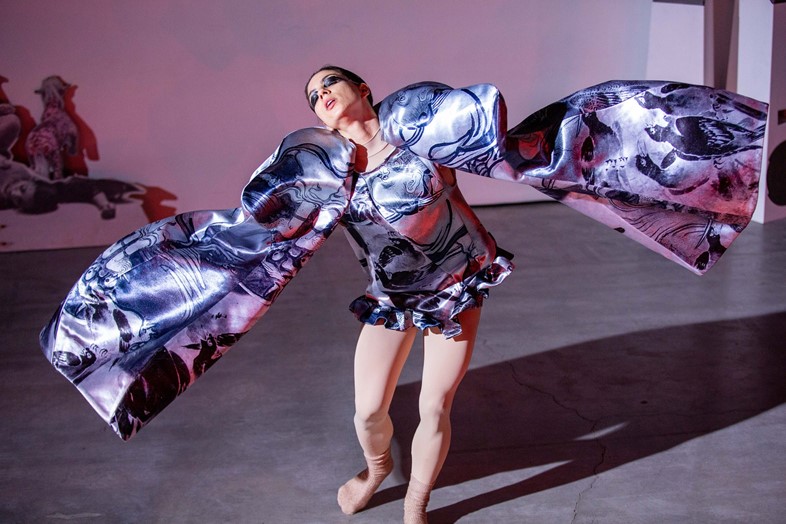
SM: Then how were the Comme des Garçons pieces incorporated into this idea?
CB: With the Comme pieces I felt confronted to turn them into moving sculptures. They are so well crafted, handmade, it fills me with emotion to see how much time has been spent to make them both strong and light, easy to wear regardless of the fact they are huge. There are parallels with the time a dancer spends to master a movement, the Comme pieces dictate the body’s movement – when worn they can be viewed as both animistic and abstract. Taking into account Rei Kawakubo’s Japanese heritage I can’t help but think about the conceptual relationship the crafting of the pieces has to the Shinto religion. It is an animistic and pantheistic religion, which recognises a spirit in objects, animals, plants or Hello Kitty.
ML: I hadn’t ever really analysed my collection of Comme but now when I see images from the performance, capturing the dancers wearing the pieces and carrying the sculptures, it feels like these three elements – bodies, the garment and the sculptures – are made for each other. The clothes are hundreds of pounds in weight; the dancers made them look so light.
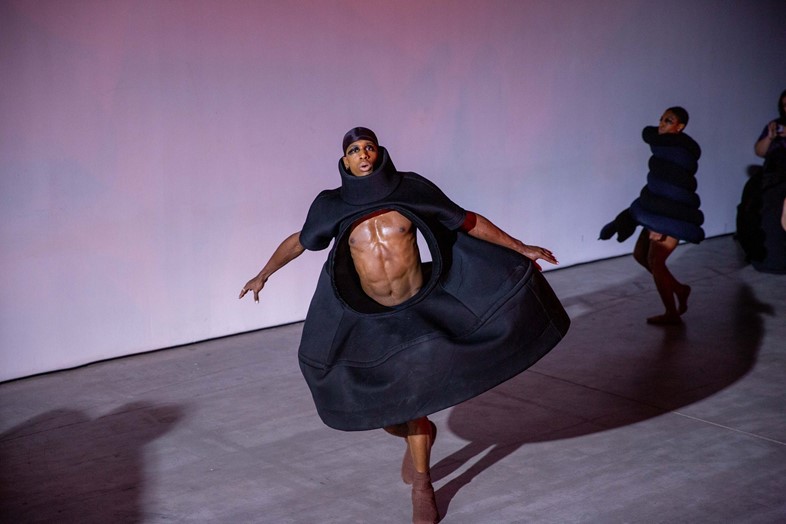
SM: All the dancers were cast from different places. Where did you find them and what were you looking for?
ML: Cecilia did the casting over FaceTime from Paris. It is amazing seeing something come together when it is meant to be. For me the whole performance was instinctive. All the dancers really wanted to be a part of it all. It was incredible how through the dancers the sculpture and clothes came together to tell the same story.
CB: Kathy Noble, the curator of Performa, helped me to find the dancers. All of them were very dedicated; each had strong beliefs in their independent practices and came from a range of backgrounds such as voguing, dancehall, ballet, boxing and modern dance. I was interested to explore whether there were common threads amongst these different practices. There are – firstly, each one is very specific and precise. I have personally explored each of these different disciplines with my own body and I feel like they each transform the state of mind and mood through meditation in movement. To me the study of different dance disciplines, from different geographic regions and history, allows me to have empathy for human kind. I look for peace and harmony through bodily rites. To see how different cultures use the body I think modifies the way we can understand.
